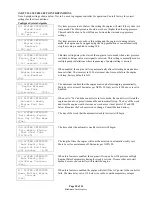
Page 4 of 34
File Name:
Doc#586p.docx
F.
A data logger is provided as standard to record system pressure along with numerous alarm conditions and system events. The
data can be displayed on the OID or can be downloaded to a PC through the RS485 port provided on the main system board.
Data is stored on an SD Memory card. This card contains individual pressure files with each file containing one days worth of
pressure data. Each file is of the PressXXX.txt format. Each entry is stamped with the date and time and system pressure at that
time. The Events.txt file contains all of the logged events with each event stamped with date and time. The SD memory card can
be removed and files transferred directly to a PC using appropriate memory card reader. The controller will continue to operate
normally with the SD card removed. There will, however, be a visual and audible alarm when the card is removed. Events and
pressure data will continue to be logged while the card is missing. The memory cards should be replaced within 12 hours to
ensure that no data is lost.
G.
A weekly test timer is supplied to automatically start the engine any set day of the week, at a set time of day, and a preset run
time. See Part IV below for more information and the System Config Screen 106.
H.
"Stop"
Pushbutton - A pushbutton is provided to stop the engine in Auto at any time provided all starting demands have
cleared. This returns the controller to the automatic position. The Auto-Off-Manual selector switch can also be put in the “Off”
mode to stop the engine. Any starting commands will not start the engine in the “Off” mode.
I.
Integral Battery Chargers (Option J). There are two separate fully automatic, solid state chargers provided for maintaining full
charge on the dual sets of engine batteries. An LED display is provided on each charger to indicate charger AC input voltage is
present and DC output voltage is present.
User Preferences Screen 218 and 219 are used to determine when the Charger Failure alarm will activate. When Screen 218 is
set to No, the Charger Failure alarm will not be active while the engine is running. Should both chargers fail or switch off due to
a high voltage output from the engine alternator, the AC Power Failure lamp may come on. This is normal. It will reset
automatically once the engine stops running and the charger failure alarms reset. When Screen 218 is set to Yes, the Charger
Failure alarm will be active at all times when the Mode selector switch is in the Auto or Manual mode. Screen 219 is used to
determine the time delay between the failure contacts on the charger closing and the Charger Failure lamp and audible alarm
sounding on the controller.
J.
Cabinet - A heavy gauge steel cubicle encloses the controller. The OID, the key operated Auto-Off-Manual (AOM) Selector
Switch and manual start pushbuttons are mounted on the outer door. The battery circuit breakers are located inside the cabinet on
the main back panel of the unit. A key for the AOM switch is stored in a break-glass housing on the door of the cabinet. An
additional key is located inside the cabinet.
PART III: OPERATION OF THE CONTROLLER
A.
When the controller is the
"Auto"
mode and both circuit breakers are in the
"On"
position, the controller is in standby
condition ready to start the engine automatically. A green pilot light above the
"Auto"
button will illuminate in this mode.
Also, Battery #1 Fault and Battery #2 Fault lights should be off indicating that battery power is available.
When the water pressure drops below a level which is set in System Config Screen 101, the Controller will actuate the starter
motor and the cranking cycle will commence. In addition the
“Pump on Demand”
light will illuminate. If the engine starts and
runs, cranking will cease and the protective circuits will be operative. If the engine fails to start after six (6) crank periods,
cranking will cease, the
"Engine Failed to Start"
light will illuminate, and the alarm horn will sound. The fuel solenoid will
stay on for one hour however. This is to allow the engine to continue to run in the event the failed to start condition was due to a
faulty speed switch signal from the engine. The battery alternating circuit alternates batteries on each crank attempt unless one
battery is in a discharged state and incapable of cranking the engine. In this instance, the control will lock onto the other battery
for the remaining cranking attempts. Dry contacts for remote indication of
"Battery Failure"
are provided.
The panel is wired so that optional remote start switches may be used, such as Deluge Valve, Remote Start pushbutton, External
Pressure , These start switches will also cause the
“Pump on Demand”
light to illuminate.etc. In addition, when “Power
Failure Engine Startup” feature is enabled (System Config Screen 111), the Controller will automatically start the engine upon
loss of Battery Charger output or AC Power loss, after an adjustable time delay (System Config Screen 112).
While the engine is running, all protective circuits are operative. If the engine stops while running, and there is still an auto start
demand, the control will attempt to restart the engine. If the engine fails to start the
"Engine Failed to Start"
light will
illuminate and the alarm will sound. If, while the engine is operating, the oil pressure drops below a safe limit, the
“Low Oil
Pressure”
light will illuminate immediately. After approximately seven (7) seconds the alarm will sound. Should the engine
temperature exceed a safe limit while running, the
“Engine High Water Temp.”
light will illuminate after a seven (7) second
time delay and the alarm will sound indicating engine overheating.





































